List of Authors
>>About this blog
Recent blog post
|
[CAM]
March 26, 2016 09:00
When I went to Yurakucho and looked at it suddenly, Sukiyabashi Park, which was surrounded by obstructions during renovation, was newly opened. (All photos taken from 15:30 to 16:30 on March 24)
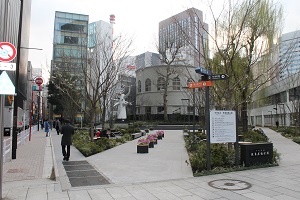
The monument of Sukiyabashi (45 pages of Monoshiri Encyclopedia) is also immediately noticeable.
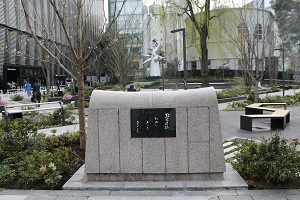
At the corner of Sotobori-dori St., "Tokyu Plaza", which was a week before opening, seemed to be in a hurry to finish the last.
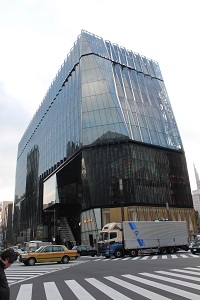
When I walked along Harumi-dori St. to Tsukiji, "Tsukiji Fish Bank" was removed from the enclosure for construction work, revealing its appearance.
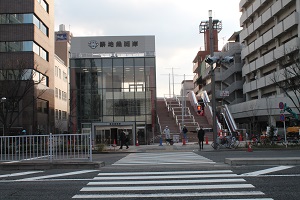
In addition, I saw the flowering of the cherry blossoms at Tsukuda Park, but it was hardly open yet. Yesterday, there was a business near Kudan Kaikan, and when I walked a little around Budokan, it felt like it was blooming for 2 to 3 minutes, but is the cherry blossoms in Tsukuda a little late?
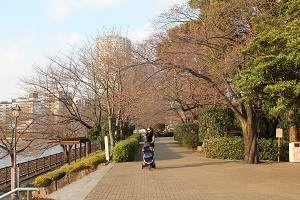
Furthermore, when I walked near River City and Chuo-ohashi Bridge, I felt like it was 1 to 2 minutes blooming here.
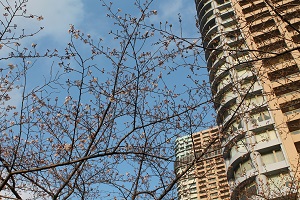
[CAM]
March 21, 2016 14:00
The above part of "Kyoko no Ie" (published in 1959) is often cited as a description of Kachidokibashi, especially the opening and closing of bridges, but "Happiness Go Deho" (serialized in 1955, published in a book in 1956) is that the main character Mitsuko grew up in Tsukishima and works in a department store in Ginza.
>Without knowing why, Mitsuko ate breakfast and left her mother alone and went to work. Every day, I walk from Tsukishima to Ginza on foot to save my footage.
Mitsuko started crossing Kachidokibashi after buying a newspaper in Hashizume, thinking that she would read it again on the rooftop during work breaks.
It's a sunny morning with no clouds. And the wind is whim. I left home earlier than usual, so no matter how much I walk, I can't afford it.
Mitsuko stopped and looked at the mouth of the bridge, which had never been stopped.
In front of the warehouse, the color of the rusted drums of the red rusted drums looked beautiful on the water shining in Asahi. On the pier on the shore of the fish bank on the other side, there was a beautiful red flag of the bonito boat. The estuary of the morning was full of energy, and from here and there, the sound of pompom steaming like the sound of heart beating with joy.
Even to Mitsuko, there was a feeling of happiness.
・・・・・
・・... Mitsuko looked at the pier near the fish shore. From there, there was a record of the popular song of our bells, and a long row of verticals came from the bonito boat. I saw young people with rubber lengths, rubber front hooks, and white headbands. They seemed to have piled up glowing knives one by one, from their hands to hands, in the manner of bucket relays of air defense exercises, and piled them up in front of the warehouse. (8-363)
Today's Tsukiji Market as seen from the Tsukishima side of Kachidokibashi
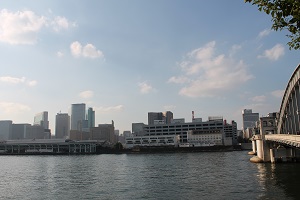
>If you go further south from Tsukishima and cross the bridge, it is out of the south of Tokyo. Harumi Wharf and Ifuna landfill. So until this time the international trade fair was opened.
Goban's eyes are quiet streets, paved roads, small trees, new sidewalks ... If this much is in the middle of Ginza, Ginza will be able to join the world's top cities, Heaven, two things are like a sample of a portable shrine, and the sidewalk of the main street is such a splendid, and grassy landfill.
The sky is so big. There was thin clouds in the sky, and the hem of the sky was swayed by the black smoke of ships and factories. (382)
Present Harumi
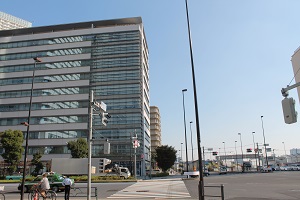
>There is a large monument on the right side just before crossing Kachidokibashi. The back was a little lower, and the white lengwa building of the Kachidoki Bridge Changing Station looked into the river.
Since the waiter is hard to appear, Toshio reads the inscription that is difficult to read with each other.
"Kachidoki Hashinoki
In the 1904 battle of the Imperial Army. In commemoration of the victory, the residents of Kyobashi will set up a ferryboat here, name it Kachidoki, and donate it to Tokyo City ... "(448)
The inscription "Kachidokibashi Museum" (the substations have been renovated)
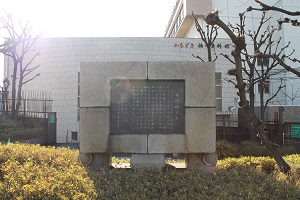
[CAM]
March 21, 2016 12:00
Yukio Mishima's novel "Kyoko no Ie" was published in 1958 (1958) in the first issue of the magazine "Voice" until Chapters 1 and 2, followed by Shinchosha in 1959 (1959) the following year. Two books, "Part 1" and "Part 2" were published at the same time.
At the beginning of this, there is a description of Kachidokibashi and its surroundings as shown below. 、
>From a distance, you can see that cars are crowded around Kachidokibashi. I wonder if it was an accident, the collection said. However, I realized that it was time for the opening and closing bridge to rise. Shunkichi beat his tongue. He said, "Let's give up or get rid of the landfill. However, Natsuo and Kyoko wanted to see the bridge that they had never seen before, so they stopped the car in front of Kanari and went to see it all across the railway bridge. Shunkichi and the harvest have a somewhat uninterested face.
The central part is a steel plate. Only that part opens and closes. Before and after that, the staff stood with a red flag, and a parked car was crowded. He was blocked by the chain of Ichijo at the end of the sidewalk. There were a considerable number of spectators, but when the traffic was blocked, there were listeners and on-sites who were selling oil.
And the iron plate on the train track was black, shy, without putting anything on it. And a man saw it from both sides.
In the meantime, the center of the steel plate began to swell. The part gradually raised his head and opened the cracks. The steel plate came up, and the railings of the steel on both sides, and the arches of the steel, with a dull light on the pillars, roughly up. Natsuo thought this movement was beautiful.
When the steel plate is finally going to be perpendicular, the dents of the countless steel studs on both sides run down with thin smoke. The small shadows of countless steel studs on both sides gradually come into contact with the steel studs, and the shadows of the balustrade on both sides gradually distorted and moved. As soon as the steel plate became completely perpendicular, the shadow was also quiet. Natsuo raised his eyes and saw a gull over the pillars of the iron arch that fell down.
・・・・・・・・・・
I've been waiting for a long time. ・・・・・
The car crossed Kachidokibashi, passed the town of Tsukishima, and further crossed Reimeibashi. The flat wilderness was blue as far as the eye could see, and a wide grid-grained paved road. The sea breeze bumped my cheeks. Shunkichi stopped his car at the runway, which is located at the end of the U.S. military facility. A few poplars were shining in the sun on the other side of the U.S. (11-10)
Current Kachidokibashi
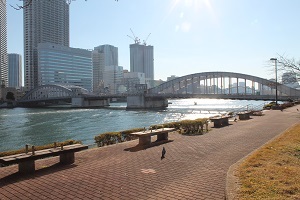 Today's Reimei Bridge Today's Reimei Bridge
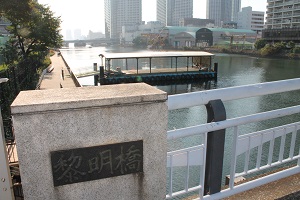
[CAM]
March 17, 2016 18:00
Yukio Mishima's novel "Happiness Go Deho" was serialized in the Yomiuri Shimbun from June to November 1955, and a book was published in 1956 (1956). The main character's brother and sister (although it is finally revealed that blood is not connected) grew up in an old rented house in Tsukishima, and his sister works in a department store in Ginza, Tsukishima and Kachidokibashi often appear during his work.
During the work, smuggling around Tokyo Bay and the Sumida River is depicted, but at that time Japan was under full protectionism and imported goods were subject to high tariffs, so smuggling goods at that time had many items such as watches and were mainly done by ships.
There are the following descriptions in the beginning of the work.
>Look at the telescope.
On the right, you can see the moss moss moss green in Hamarikyu Park and the boat lining off the sea. The horizon is faintly cloudy.
She changed the angle to the left.
The complicated building looked like a piece of Oshie. The T hot spring building, its Mukamu T theater, and the green side of the green roof at Tsukiji Honganji Temple in Mukamu, look like a layered painting one after another. The scarce smoke of the large chimneys of the high T hot spring distorted the landscape of the distant port, like a shadow. The only thing you hear is the horn of a car that echoes and rises all over the valley of the building.
Suddenly, the scorched point of the lens is fixed to the bridge that connects the fish shore, and clearly shows the willow at the side of the bridge and the self-turned car. But that's not what she wants to see. Turn the lens just a little to the left. On the outskirts of the roof of the fish riverbank, the quench of the bonded warehouse on the opposite bank of Kachidokibashi looked like him. (8-352)
There is a store in N department store, but it is unknown whether Matsuya, Mitsukoshi or Matsuzakaya. Since Matsuzakaya is under construction, we examined the view from the roof of the current Matsuya and Mitsukoshi department stores.
Even if you look at the Sumida River from the roof of Matsuya, you can hardly see the view as follows. You can barely see the top of the St. Luke's Tower.
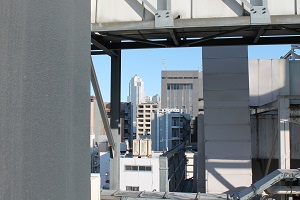
From the 12th floor of Mitsukoshi, you can see the East Drama Building, but you can't see Hamarikyu or Tsukiji Honganji.
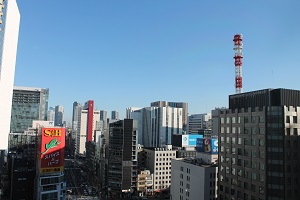
[CAM]
March 13, 2016 09:00
At the "Chuo-ku Marugoto Museum" last fall, 11 public baths in the city are listed as "Whole Museum Day Go empty-handed to a public bath."
Of these, three houses are located in the Tsukuda and Tsukishima areas. The remaining 8 houses are Ginza Yu (Ginza 1-12-2), Kinharuyu (Ginza 8-7-5), Irifune Yu (3-6-14), Minato Yu (Minato 1-6-2), Kotobuki Yu (Tsukiji 6-12-4), World Yu (Nihonbashi Ningyocho 2-17-2), Jushidokiyu (Nihonbashi Kodokidoki, 5.
However, there is a notice at Asahiyu (Tsukuda 2-12-12) in the Tsukuda area that it will close on the 29th.
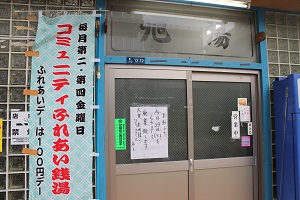
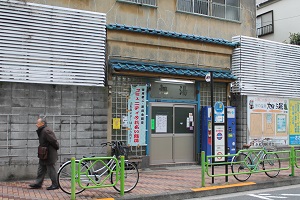
In the Tsukuda area, only Hinodeyu (Tsukuda 1-6-7) near Tsukuda Kobashi was left.
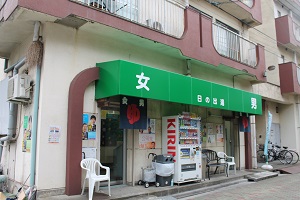
You seem to have a rental apartment on the upstairs.
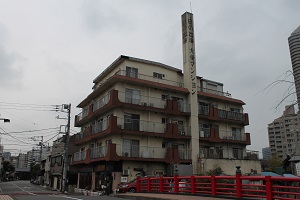
Tsukishima Onsen (3-4-5 Tsukishima) is located in the Tsukishima area. It faces Monja Street and is located on Tsukishima Kannon.
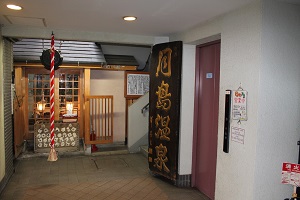
It is lonely that private shops such as greengrocers, fish shops, liquor stores, electronics stores, etc. disappear, but if the number of users decreases, it will not be feasible as a business.
[CAM]
March 11, 2016 16:00
The e-mail magazine of the Yukio Mishima Study Group has been transcribed (the e-mail magazine is free to transfer).
In Mishima's work, there are not so many things that Chuo-ku appears, but Tsukishima etc. will appear in "Happiness Go Deho".
> Information on the Yukio Mishima Study Group, Membership Event "Bridge Tsukushi Tour"
@@@@@@@@@@@@@@@@@@@@@@@@@@@@
Set in Ginza and Tsukiji, the famous short story "Hashizukushi" (published in 1958), depicting the sadness of women who cross seven bridges on the full moon night on August 15 in the lunar calendar. (Received in Shincho Bunko "Hanazakari no Mori / Yukuni").
This time, we planned an event to walk around the six bridges that were the stage of this work, and to taste the stage of this work again.
At the start of the tour, Mr. Mishima and members of Tatenokai will have lunch at the Kappo cuisine "Suegen" in Shimbashi where the last dinner party was held.
After that, we plan to walk around the seven bridges (actually six) that appear in the work in order.
Finally, we plan to visit Kachidokibashi, which is also wonderful at the beginning of Kyoko's House, and visit Tsukiji Honganji, where Mr. Mishima's main funeral was held.
If you have time, we will also hold a social gathering in the neighborhood (actual cost).
Description
Date and time June Saturday, June 4, 2016 11:15 Meeting
Meeting place SL Plaza west of JR Shimbashi Station
Scheduled course Shimbashi / "Suegen" (lunch)-Ginza Itajindo-Kinharu-dori-Showa-dori-Miyoshibashi-Tsukijibashi-Irifunebashi-Akatsuki Bridge-Sakae Bridge-Bizenbashi-Kachidokibashi-Tsukiji Honganji (Kachidokibashi is not included in this work)
Scheduled to be dissolved around 16:00
Please pay the transportation expenses on the day and the lunch fee at the end (approximately 1,000 yen to 1,600 yen) by yourself.
You will walk for about two hours, easy-to-walk clothes and come with your feet.
If you would like to participate, please apply by e-mail or fax to our secretariat.
E-mail: [email protected]
FAX 03-5419-7670
Please write "I would like to participate in the bridge tour" and let us know your name and phone number (mobile phone).
|
Links
|

